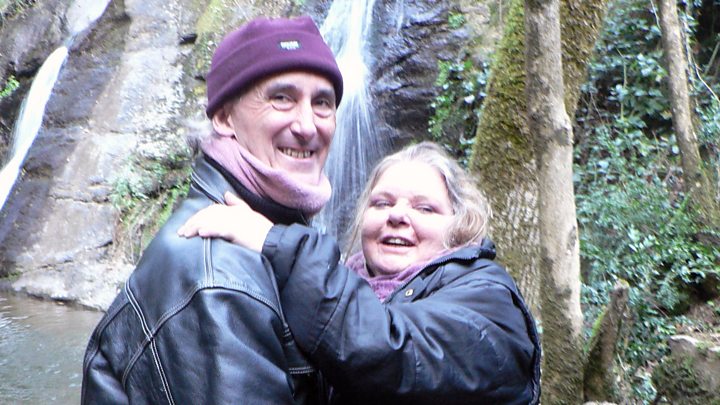Contaminated blood scandal: Inquiry hearings to begin

Media playback is unsupported on your device
A public inquiry into what has been called “the worst treatment scandal in the history of the NHS” is to start taking evidence on Tuesday.
Some 4,800 people with haemophilia were infected with hepatitis C or HIV in the 1970s and 1980s. More than 2,000 are thought to have died.
Thousands more may have been exposed through blood transfusions after an operation or childbirth.
One victim’s widow says she wants “justice” and people held to account.
Su Gorman’s husband, Steve Dymond, died aged 62 on 23 December last year of organ failure – ultimately caused by the medicine he was given as a young man.
‘The wonder drug’
Speaking to the Victoria Derbyshire programme in April 2018, Steve said: “It’s not the life I imagined in terms of dreams, in terms of ambitions.
“It’s become a life of sickness, illness, worry, anxiety.
“When I talk about my wife, I talk about her as my widow in waiting.”
Steve was born in 1956 with a mild form of haemophilia, a genetic condition that prevents blood from clotting properly.
He played rugby at school and studied Russian at university where he met his wife, Su, waiting on a train platform.
“He had a massive bruise on his thigh the size of a postcard and it worried me,” she remembers.
“Steve was not in the habit of getting treatment, so he said he would get it checked out. That was the first time they injected him with a ‘wonder drug’ called Factor VIII.”
At the time that new drug was made from the pooled blood plasma of tens of thousands of donors.
In the 1970s and 1980s, the NHS was importing Factor VIII from the US, where high-risk groups like prisoners were paid to give blood.
The first sign that something was very wrong came in about 1983.
Reports of a new form of cancer started to emerge, first in the gay community then among other groups like haemophiliacs.
Around this time, Steve had a minor accident and went to the local hospital to get it checked out.
“The young registrar took a packet off the shelf and treated him with Factor VIII. The bruise disappeared after an hour, so it was totally unnecessary,” said Su.
“Shortly after, they called him back and said he had been exposed to HIV.”
The testing process took 18 months – an “absolutely terrifying” period.
Some 1,200 British haemophiliacs were infected with HIV in this way, including many young children of primary school age. Only 250 are still alive today.
Steve was one of the lucky ones.
“It was a huge relief. He was told he was clear of the HIV but no mention was made of the Hepatitis C at that point,” says Su.
The ‘silent killer’
Hepatitis C is a virus now thought to affect more than 150 million people, some 2% of the world population. Yet it was not discovered and named until 1989.
It was not until 1993, then living and working in France, that Steve was told he had the condition.
At the time the couple were trying again for a baby. They were immediately taken off the IVF programme.
“Steve was told bluntly that the [possible] consequences were liver cirrhosis, cancer, a transplant, premature death,” says Su.
“Within 24 hours [of diagnosis] we found out we would never have children and that he was going to die early.”
Damage was done
It was only in 2013 that a new drug was approved that could successfully eliminate the Hepatitis C virus from Steve’s body.
By then, though, the damage was already done. Scans showed his liver was cirrhotic and a bunch of cells showed the early signs of cancer.
His health declined quickly in the last 18 months of his life.

Media playback is unsupported on your device
In late December 2018 he woke at home coughing up blood.
“They took him to intensive care. He knew I was there and he said to me, ‘I love you’,” says Su.
“The last thing he said was he wanted those who had done this to him to repent. Then at one in the morning, as he was holding my hand, he left me.”
The inquiry
A public inquiry into the scandal was first announced in July 2017.
Since then, campaign groups estimate that more than 150 infected haemophiliacs like Steve have died.
The inquiry will consider evidence from approximately 2,500 people, most of whom were infected with, or affected by, contaminated blood products such as Factor VIII or IX.
Victims and relatives want to know why warnings about the safety of the medicine may have been ignored, why plans to make the UK self-sufficient in blood products were scrapped, and why many documents and patient records appear to have been lost or destroyed.
The inquiry, led by retired judge Sir Brian Langstaff, could last for more than two years.
Ahead of the public hearings, the government announced more financial support for people in England affected by the tragedy, to a total of £75m from £46m.
The Department of Health and Social Care has called the infected blood scandal “a tragedy that should never have happened”, adding that “the ongoing public inquiry was set up to get to the truth and give families the answers they deserve”.
“I want to see justice,” says Su.
“I want to see people called to account, I want to see anybody found to have behaved inappropriately, criminally or negligently made to explain themselves.
“Steve’s dying words were he wanted them to repent. I promised him they would, and that’s a promise I intend to keep.”
Follow the BBC’s Victoria Derbyshire programme on Facebook and Twitter – and see more of our stories here.

